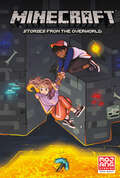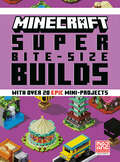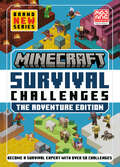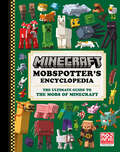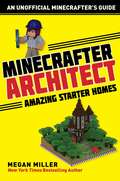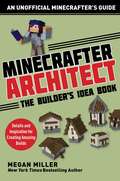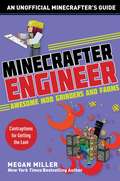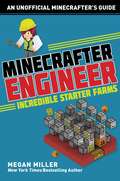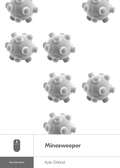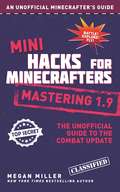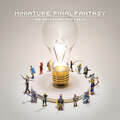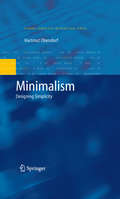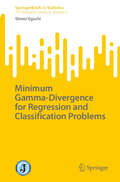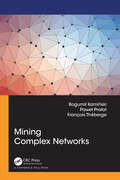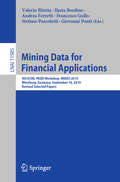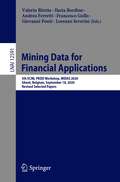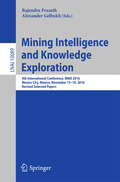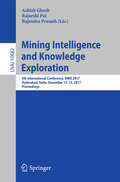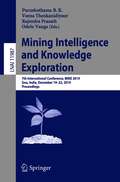- Table View
- List View
Minecraft: Roll for Adventure: The Temple of the Charged Creeper (Minecraft)
by Matt Forbeck Marty ForbeckRoll the dice to create your very own Minecraft story in this tabletop game—with instructions and an adventure book!When a village is raided by illagers, its poor inhabitants seek the aid of a mighty hero to track down the invaders. They need someone brave, clever, and determined. They need you!Make crucial decisions, craft powerful items, roll dice to battle mobs, and explore the Overworld on your epic journey to discover and destroy the mysterious Temple of the Charged Creeper. This book contains:• A complete adventure book with a bestiary of wicked mobs and a collection of perilous adventure locations.• A character sheet and rules reference to help you track your heroic progress (or to let you play with your friend as your narrator!).So sharpen your sword, prepare your pickaxe, and grab your dice. Your epic Minecraft adventure begins now!
Minecraft: Stories from the Overworld (Graphic Novel)
by Hope Larson Ian Flynn Stephen McCranie Rafer RobertsFrom blocks to panels! Minecraft returns to comics in this stand-alone anthology collection of officially licensed, original comic stories!With tales of witch and pillager rivals finding common ground, a heartless griefer who bit off more than they could chew, and valiant heroes new (or not!) to the Overworld, this anthology tells tales that span the world of Minecraft. Featuring stories from star writers Hope Larson (Batgirl), Kevin Panetta (Zodiac Starforce, Bloom), Rafer Roberts (Modern Fantasy, Grumble), and Ian Flynn (Sonic, Mega Man) and exciting artists Meredith Gran (Octopus Pie) and more, this collection brings together stories from all realms, leaving no block unturned!
Minecraft: Super Bite-Size Builds (Minecraft)
by Mojang AB The Official Minecraft TeamThe next book in the popular Bite-Size Builds series, following Bite-Size Builds and Amazing Bite-Size Builds. Learn how to design, build and customize over twenty new mini-projects in Minecraft. With detailed instructions, block hacks and build tips, this book will teach you new tricks and help you practice old skills as you create bite-size builds to impress your friends in Minecraft.
Minecraft: The Adventure Edition (Minecraft)
by Mojang ABSurvive 30 thrilling challenges in the first book of a new Minecraft series!Are you ready to take your Minecraft survival skills to another level? However you love playing, this book is packed with challenges that will improve your ability and inspire fun new ways to enjoy the world of Minecraft, on your own or with friends.Complete with amazing illustrations and expert tips throughout, this book will guide you on a journey to become a Minecraft survival expert!
Minecraft: The Ultimate Guide to the Mobs of Minecraft (Minecraft)
by Mojang AB The Official Minecraft TeamIt&’s time for adventure! Discover all there is to know about every mob in Minecraft in the official Mobspotter&’s Encyclopedia: The Ultimate Guide to the Mobs of Minecraft. You&’ll meet seven expert guides, who are full of stories of their fun experiences, and be taken on a tour to explore every corner of the Overworld. You&’ll even navigate to the Nether and experience the End dimension, on a thrilling journey to witness all seventy-nine mobs in existence.Discover how to survive a shoot-out with skeletons, dive for treasure with dolphins or risk a run-in with the Ender Dragon—and then start a whole new adventure of your own!
Minecraft: Updated Edition (Minecraft)
by Mojang AB The Official Minecraft TeamA completely updated version of the bestselling Minecraft: Blockopedia! Detailing each block found in the #1 game of all time, this is a must-have reference guide for all Minecrafters!This fully illustrated guide contains information on each of the blocks that make up the Minecraft world. It&’s a beautiful and comprehensive reference tool for beginners and more experienced players alike, with essential information on every block&’s properties, as well as little-known trivia and expert advice on what to do with each one! From basic plants and ores to enchantment tables and End stone, you&’ll find everything you need to know in the Blockopedia.
Minecrafter Architect: Amazing Starter Homes (Architecture for Minecrafters)
by Megan MillerThe Architecture for Minecrafters series is designed to encourage confidence and creativity by teaching kids to build a wide array of uniquely sophisticated structures. Each book in the series helps players follow blueprints to create impressive masterpieces that are as fantastic as they are functional. Minecrafter Architect: Amazing Starter Homes is the first in this inspiring new series. Guided by hundreds of in-game, step-by-step photos and simple instructions, kids will learn how to build one of ten amazing homes so that they can create interesting and reliable shelter anywhere they spawn. Igloo compounds, prairie houses, and llama ranches are just some of the killer designs that await them when they follow the techniques laid out in this book. With tips for adding d?cor and landscaping touches to their new builds, players can have fun bringing each new home to life. Perfect for beginner to advanced Minecrafters who want to learn more Includes hundreds of step-by-step, full-color photos to guide readers of all ages Helps encourage creativity and problem-solving skills Kids who want to try their hand at virtual design will love the tricks and tips inside this book! Minecrafter Architect: Amazing Starter Homes holds the valuable secrets they need to flex their in-game building skills.
Minecrafter Architect: Details and Inspiration for Creating Amazing Builds (Architecture for Minecrafters)
by Megan MillerBecome a Master Builder of Structures! <P><P>Tired of the same old 9x9 cobblestone cubes? Stuck figuring out what type of windows to add to your mansion? Minecrafter Architect: The Builder’s Idea Book will solve your builder’s block, with dozens of examples of window treatments, entranceways, roofs, walls, paths, road, bridges, floorplans, block palettes, and more. Copy them exactly or use them as inspiration, and you’ll be mastering the art of creating unique and detailed Minecraft builds. <P><P>Guided by hundreds of in-game, step-by-step photos and simple instructions, kids will learn how to add excitement, artistry, and variety to everything they build. Perfect for beginner to advanced Minecrafters who want to learn more Includes hundreds of step-by-step, full-color photos to guide readers of all ages <br>Helps encourage creativity and problem-solving skills <P><P>Minecrafter Architect: The Builder’s Idea Book appeals to the virtual artist in every gamer and holds the valuable secrets players need to stretch their building skills.
Minecrafter Engineer: Contraptions for Getting the Loot (Engineering for Minecrafters)
by Megan MillerYou have your farms of cactus, wheat, melons, and sugarcane. You have some decent armor and a nice base. Now you need more. More blaze rods, more iron, more wither skeleton skulls, more gunpowder, more enchanted books, more everything! <P><P>Minecrafter Engineer: Incredible Mob Grinders teaches kids how to build the incredible mob farms the experts use to increase their wealth and loot, from the witch farm to the iron golem trap. <P><P>The Minecraft Engineer series is designed to encourage creativity and problem-solving skills in kids who love building in Minecraft. <P><P>Each book helps players work within the physics of the game to build clever contraptions that add to their gaming experience. Guided by hundreds of in-game, step-by-step photos and simple instructions, kids will learn how to engineer one of many incredible mob grinders to yield resources and goodies beyond their wildest dreams. (Hundreds of chests to hold your booty not included.) <P><P>Perfect for beginner to advanced Minecrafters who want to learn more <P><P>Includes hundreds of step-by-step, full-color photos to guide readers of all ages <P><P>Helps encourage creativity and problem-solving skills <P><P>You’re not an expert gamer until you learn the tricks and tips in this book! <P><P>Minecrafter Engineer holds the valuable secrets to becoming the Minecrafter engineer you’ve always wanted to be.
Minecrafter Engineer: Incredible Starter Farms (Engineering for Minecrafters)
by Megan MillerThe Engineering for Minecrafters series is designed to encourage creativity and problem-solving skills in kids who love building in Minecraft. Each book helps players work within the physics of the game to build clever farms, ultra-efficient railways, automated redstone-fueled contraptions, and more. Minecrafter Engineer: Incredible Starter Farms is the first in this compelling and inspiring new series. Guided by hundreds of in-game, step-by-step photos and simple instructions, kids will learn how to engineer one of seven spectacular farms to yield resources and goodies beyond their wildest dreams. Stacks of sugarcanes, gobs of gold, and bushels of blaze rods are the rewards that await them when they follow the techniques laid out in this book. Perfect for beginner to advanced Minecrafters who want to learn more Includes hundreds of step-by-step, full-color photos to guide readers of all ages Helps encourage creativity and problem-solving skills They?re not an expert gamer until they learn the tricks and tips in this book! Minecrafter Engineer: Incredible Starter Farms holds the valuable secrets to becoming the Minecrafter engineer they?ve always wanted to be.
Minesweeper (Boss Fight Books)
by Kyle OrlandIf you had some free time and a Windows PC in the 1990s, your mouse probably crawled its way to Minesweeper, an exciting watch-where-you-click puzzle game with a ticking clock and a ton of &“just one more game&” replayability. Originally sold as part of a &“big box&” bundle of simple games, Minesweeper became a cornerstone of the Windows experience when it was pre-installed with every copy of Windows 3.1 and decades of subsequent OS updates. Alongside fellow Windows gaming staple Solitaire, Minesweeper wound up on more devices than nearly any other video game in history. Sweeping through a minefield of explosive storylines, Journalist Kyle Orland reveals how Minesweeper caused an identity crisis within Microsoft, ensnared a certain Microsoft CEO with its addictive gameplay, dismayed panicky pundits, micromanagers, and legislators around the world, inspired a passionate competitive community that discovered how to break the game, and predicted the rise of casual gaming by nearly two decades.
Mini Hacks for Minecrafters: The Unofficial Guide to the Combat Update
by Megan MillerWith Minecraft’s latest version, the Combat Update, everything you know and love about your favorite game has changed. Learn how to master Minecraft 1.9 with this all-encompassing guide to using the game’s new features!When you play the latest version of Minecraft, you’ll discover new features including poison-tipped arrows, dual-wielding axes and shields, and a meaner and badder Ender Dragon. From overhauled combat mechanics to a revamped End dimension, this guide covers everything you need to know about exciting new gameplay features, items, blocks, and entities, including:COMBAT TRICKS-like sweep attacks and crushing axe blows!MASTERING MONSTERS-how to summon, find, and beat the Ender Dragon, shulkers, and skeleton horse traps!TREASURE HUNTING AND EXPLORING-how to find treasure in igloos and End ships!And HOW TO FLY AND WALK ON WATER!Written for Minecrafters ages seven to twelve, this book is an unofficial "hacker’s” super guide. All the in-depth knowledge you expect from Megan Miller’s Hacks for Minecrafters series is available here in a smaller, more convenient size-pared down to just the essential tricks and tips you need to become a Combat Update expert!
Mini Hacks for Pokémon GO Players: Secret Tips for Mastering the Game
by Justin RyanPokémon GO has taken the world by storm, and now everyone can play by using the Mini Hacks book to become a winner. If you’re a confused beginner, or a level 15 player, Mini Hacks for Pokémon GO Players will give you the basics on how to play the game. Includes tips and techniques for finding Pokémon, leveling up, PokéStops, and more. Also includes important information on issues like safety and extending battery life.Written for Pokémon GO players ages seven and up, this book is an unofficial "hacker’s” guide to the game. The format follows our bestselling Hacks for Minecrafters books, only in a smaller, more convenient mini size-but still contains the essential tricks and tips you need to become a Pokémon GO top level trainer!
Mini Hacks for Pokémon GO Players: Skills, Tips, and Techniques for Capture and Battle
by Justin RyanPokémon GO has taken the world by storm, and now everyone can master the game by using the Mini Hacks book to play - and fight! Mini Hacks for Pokémon GO Players: Combat focuses on the battling element to the game. Includes tips and techniques for capturing Pokémon, training them in a gym, and then using them to battle other trainers. Which is, of course, the object of the game.Written for Pokémon GO players ages seven and up, this book is an unofficial "hacker’s” guide to the game. The format follows our bestselling Hacks for Minecrafters books, only in a smaller, more convenient mini size-but still contains the essential tricks and tips you need to become a Pokémon GO top level trainer!
Mini Hacks for Pokémon GO Players: Skills, Tips, and Techniques for Capturing Monsters
by Justin RyanYou’re on the hunt for all 151. Some are easy, others are super hard and elusive. Mini Hacks for Pokémon GO Players: Catching focuses on strategies to help build your Pokémon collection. Includes tips and techniques on:Ball tossing-how to perfect the curve What type of Poké Balls you need for specific monstersHow to most effectively use Razz BerriesWhere you are most likely to find and capture specific typesThe scoop on Lures and Incense to boost catchability Catch all of the Mini Hacks for Pokémon GO Players!
Miniature Final Fantasy
by Square Enix Tatsuya TanakaA whimsical collection of iconic scenes from the Final Fantasy series, cheerfully realized by miniature photographer Tatsuya Tanaka!Cloud and Sephiroth reenact their fateful showdown--an open beer can standing in for Nibel Reactor cooling tower. Setzer steers his airship Blackjack, mischievously recreated from corn on the cob. A chocobo flits and frolics across a field of . . . tennis balls. Tetsuya Tanaka's vibrant miniature photography is showcased side-by-side with concept art that details the process of each photo's creation. This tome catalogs fan-favorite moments captured from across the Final Fantasy series, followed by a longform interview with Tatsuya Tanaka himself. Dark Horse Books and Square Enix present Miniature Final Fantasy: No Adventure Too Large--Tatsuya Tanaka's miniature Final Fantasy scenes from his memorable Miniature Calendar series. This joyous collaboration celebrates the Final Fantasy series from a wholly unique perspective.
Minimalism
by Hartmut ObendorfThe notion of Minimalism is proposed as a theoretical tool supporting a more differentiated understanding of reduction and thus forms a standpoint that allows definition of aspects of simplicity. Possible uses of the notion of minimalism in the field of human-computer interaction design are examined both from a theoretical and empirical viewpoint, giving a range of results. Minimalism defines a radical and potentially useful perspective for design analysis. The empirical examples show that it has also proven to be a useful tool for generating and modifying concrete design techniques. Divided into four parts this book traces the development of minimalism, defines the four types of minimalism in interaction design, looks at how to apply it and finishes with some conclusions.
Minimum Gamma-Divergence for Regression and Classification Problems (SpringerBriefs in Statistics)
by Shinto EguchiThis book introduces the gamma-divergence, a measure of distance between probability distributions that was proposed by Fujisawa and Eguchi in 2008. The gamma-divergence has been extensively explored to provide robust estimation when the power index γ is positive. The gamma-divergence can be defined even when the power index γ is negative, as long as the condition of integrability is satisfied. Thus, the authors consider the gamma-divergence defined on a set of discrete distributions. The arithmetic, geometric, and harmonic means for the distribution ratios are closely connected with the gamma-divergence with a negative γ. In particular, the authors call the geometric-mean (GM) divergence the gamma-divergence when γ is equal to -1. The book begins by providing an overview of the gamma-divergence and its properties. It then goes on to discuss the applications of the gamma-divergence in various areas, including machine learning, statistics, and ecology. Bernoulli, categorical, Poisson, negative binomial, and Boltzmann distributions are discussed as typical examples. Furthermore, regression analysis models that explicitly or implicitly assume these distributions as the dependent variable in generalized linear models are discussed to apply the minimum gamma-divergence method. In ensemble learning, AdaBoost is derived by the exponential loss function in the weighted majority vote manner. It is pointed out that the exponential loss function is deeply connected to the GM divergence. In the Boltzmann machine, the maximum likelihood has to use approximation methods such as mean field approximation because of the intractable computation of the partition function. However, by considering the GM divergence and the exponential loss, it is shown that the calculation of the partition function is not necessary, and it can be executed without variational inference.
Mining Complex Networks
by Bogumil Kaminski Pawel Prałat Francois ThebergeThis book concentrates on mining networks, a subfield within data science. Data science uses scientific and computational tools to extract valuable knowledge from large data sets. Once data is processed and cleaned, it is analyzed and presented to support decision-making processes. Data science and machine learning tools have become widely used in companies of all sizes. Networks are often large-scale, decentralized, and evolve dynamically over time. Mining complex networks aim to understand the principles governing the organization and the behavior of such networks is crucial for a broad range of fields of study. Here are a few selected typical applications of mining networks: Community detection (which users on some social media platforms are close friends). Link prediction (who is likely to connect to whom on such platforms). Node attribute prediction (what advertisement should be shown to a given user of a particular platform to match their interests). Influential node detection (which social media users would be the best ambassadors of a specific product). This textbook is suitable for an upper-year undergraduate course or a graduate course in programs such as data science, mathematics, computer science, business, engineering, physics, statistics, and social science. This book can be successfully used by all enthusiasts of data science at various levels of sophistication to expand their knowledge or consider changing their career path. Jupiter notebooks (in Python and Julia) accompany the book and can be accessed on https://www.ryerson.ca/mining-complex-networks/. These not only contain all the experiments presented in the book, but also include additional material. Bogumił Kamiński is the Chairman of the Scientific Council for the Discipline of Economics and Finance at SGH Warsaw School of Economics. He is also an Adjunct Professor at the Data Science Laboratory at Ryerson University. Bogumił is an expert in applications of mathematical modeling to solving complex real-life problems. He is also a substantial open-source contributor to the development of the Julia language and its package ecosystem. Paweł Prałat is a Professor of Mathematics in Ryerson University, whose main research interests are in random graph theory, especially in modeling and mining complex networks. He is the Director of Fields-CQAM Lab on Computational Methods in Industrial Mathematics in The Fields Institute for Research in Mathematical Sciences and has pursued collaborations with various industry partners as well as the Government of Canada. He has written over 170 papers and three books with 130 plus collaborators. François Théberge holds a B.Sc. degree in applied mathematics from the University of Ottawa, a M.Sc. in telecommunications from INRS and a PhD in electrical engineering from McGill University. He has been employed by the Government of Canada since 1996 where he was involved in the creation of the data science team as well as the research group now known as the Tutte Institute for Mathematics and Computing. He also holds an adjunct professorial position in the Department of Mathematics and Statistics at the University of Ottawa. His current interests include relational-data mining and deep learning.
Mining Data for Financial Applications: 4th ECML PKDD Workshop, MIDAS 2019, Würzburg, Germany, September 16, 2019, Revised Selected Papers (Lecture Notes in Computer Science #11985)
by Valerio Bitetta Ilaria Bordino Andrea Ferretti Francesco Gullo Stefano Pascolutti Giovanni PontiThis book constitutes revised selected papers from the 4th Workshop on Mining Data for Financial Applications, MIDAS 2019, held in conjunction with ECML PKDD 2019, in Würzburg, Germany, in September 2019. The 8 full and 3 short papers presented in this volume were carefully reviewed and selected from 16 submissions. They deal with challenges, potentialities, and applications of leveraging data-mining tasks regarding problems in the financial domain.
Mining Data for Financial Applications: 5th ECML PKDD Workshop, MIDAS 2020, Ghent, Belgium, September 18, 2020, Revised Selected Papers (Lecture Notes in Computer Science #12591)
by Valerio Bitetta Ilaria Bordino Andrea Ferretti Francesco Gullo Giovanni Ponti Lorenzo SeveriniThis book constitutes revised selected papers from the 5th Workshop on Mining Data for Financial Applications, MIDAS 2020, held in conjunction with ECML PKDD 2020, in Ghent, Belgium, in September 2020.*The 8 full and 3 short papers presented in this volume were carefully reviewed and selected from 15 submissions. They deal with challenges, potentialities, and applications of leveraging data-mining tasks regarding problems in the financial domain. *The workshop was held virtually due to the COVID-19 pandemic. “Information Extraction from the GDELT Database to Analyse EU Sovereign Bond Markets” and “Exploring the Predictive Power of News and Neural Machine Learning Models for Economic Forecasting” are available open access under a Creative Commons Attribution 4.0 International License via link.springer.com.
Mining Intelligence and Knowledge Exploration
by Rajendra Prasath Alexander GelbukhThis book constitutes the refereed proceedings of theThird International Conference on Mining Intelligence and KnowledgeExploration, MIKE 2015, held in Hyderabad, India, in December 2015. The 48 full papers and 8 short papers presented togetherwith 4 doctoral consortium papers were carefully reviewed and selected from 185submissions. The papers cover a wide range of topics including informationretrieval, machine learning, pattern recognition, knowledge discovery,classification, clustering, image processing, network security, speechprocessing, natural language processing, language, cognition and computation,fuzzy sets, and business intelligence.
Mining Intelligence and Knowledge Exploration
by Anil Kumar Vuppala Rajendra Prasath T. KathirvalavakumarThis book constitutes the refereed proceedings of theThird International Conference on Mining Intelligence and KnowledgeExploration, MIKE 2015, held in Hyderabad, India, in December 2015. The 48 full papers and 8 short papers presented togetherwith 4 doctoral consortium papers were carefully reviewed and selected from 185submissions. The papers cover a wide range of topics including informationretrieval, machine learning, pattern recognition, knowledge discovery,classification, clustering, image processing, network security, speechprocessing, natural language processing, language, cognition and computation,fuzzy sets, and business intelligence.
Mining Intelligence and Knowledge Exploration: 5th International Conference, MIKE 2017, Hyderabad, India, December 13–15, 2017, Proceedings (Lecture Notes in Computer Science #10682)
by Ashish Ghosh, Rajarshi Pal and Rajendra PrasathThis book constitutes the refereed post-conference proceedings of the 5th International Conference on Mining Intelligence and Knowledge Exploration, MIKE 2017, held in Hyderabad, India, in December 2017. The 40 full papers presented were carefully reviewed and selected from 139 submissions. The papers were grouped into various subtopics including arti ficial intelligence, machine learning, image processing, pattern recognition, speech processing, information retrieval, natural language processing, social network analysis, security, and fuzzy rough sets.
Mining Intelligence and Knowledge Exploration: 7th International Conference, MIKE 2019, Goa, India, December 19–22, 2019, Proceedings (Lecture Notes in Computer Science #11987)
by Rajendra Prasath Purushothama B. R. Veena Thenkanidiyoor Odelu VangaThis book constitutes the refereed conference proceedings of the 7th International Conference on Mining Intelligence and Knowledge Exploration, MIKE 2019, held in Goa, India, in December 2019. The 31 full papers were carefully reviewed and selected from 83 submissions. The accepted papers were chosen on the basis of research excellence, which provides a body of literature for researchers involved in exploring, developing, and validating learning algorithms and knowledge-discovery techniques. Accepted papers were grouped into various subtopics including evolutionary computation, knowledge exploration in IoT, artificial intelligence, machine learning, image processing, pattern recognition, speech processing, information retrieval, natural language processing, social network analysis, security, fuzzy rough sets, and other areas.

